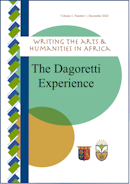Dagoretti : claiming land and space in the city
Abstract
The essay examines Dagoretti's transformation in three key moments: Generational Land Ownership: After the Mau Mau uprising, African families, including Mr. N's, were allocated land in Dagoretti. Over three generations, the family's transition from squatters to legal landholders reflects increasing stability and permanence. The second is Rental Income and Demolitions: Informal rental housing has been crucial in Dagoretti, but these structures often face demolition for not meeting city building codes. Despite this, informal settlements persist, highlighting the struggle for space in Nairobi's growing urban landscape. The last moment is the Shift from Agriculture to Residential Use: As Dagoretti urbanized, land values rose, and pressure to sell increased. The tension between maintaining cultural heritage and adapting to urbanization reflects the area’s ongoing transformation and identity struggle.
References
Chege, M. (1981). A Tale of Two Slums: Electoral Politics in Mathare and Dagoretti. Review of African Political Economy, 20, 74–88.
Kimari, W. (2023). Resisting imperial erasures: Matigari ruins and relics in Nairobi. Journal of Eastern African Studies. https://www.tandfonline.com/doi/abs/10.1080/17531055.2023.2231787
Kimari, W., & Cap, C. (2022, March 12). Under Fire: Forced Evictions and Arson Displace Nairobi’s Poor - The Elephant. The Elephant. https://www.theelephant.info/analysis/2022/03/12/under-fire-forced-evictions-and-arson-displace-nairobis-poor/
Lines, K., & Makau, J. (2018). Taking the long view: 20 years of Muungano wa Wanavijiji, the Kenyan federation of slum dwellers. Environment and Urbanization, 30(2), 407–424. https://doi.org/10.1177/0956247818785327
Overton, J. (1988). The Origins of the Kikuyu Land Problem: Land Alienation and Land Use in Kiambu, Kenya, 1895-1920. African Studies Review, 31(2), 109–126. https://doi.org/10.2307/524421
Downloads
Published
Issue
Section
License
Copyright (c) 2024 Raquel Jerobon

This work is licensed under a Creative Commons Attribution 4.0 International License.

